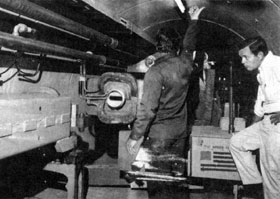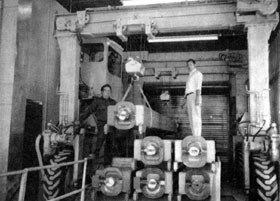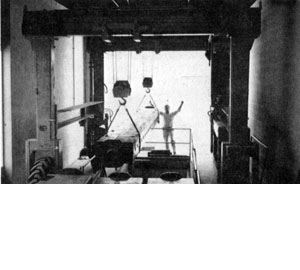Main Ring Staff Works Around-the-Clock to Tune Accelerator
The day and night efforts of many men and women are involved in the final efforts to get NAL's accelerator system "on the beam." They are uncovering and solving a number of problems, especially in the complex Main Accelerator -- the largest single component (four miles in circumference) in the NAL system. A partially collapsed vacuum chamber was found in a magnet. A piece of scrap copper was discovered to be shorting out turns of a coil. In spite of these and other technical problems, eight turns of the beam were circulated through the system at the end of June.
At 2:30 a.m. Sunday morning, August 1, a coasting beam was achieved in the Main Ring. Ernie Malamud, Main Ring, in a recent memorandum to all members of the Main Ring section, observed: "All of you contributed to the attainment of this significant milestone by your dedication and hard work."
Malamud's memorandum summarized how the coasting beam was obtained and what it means:
"Bringing the accelerator into operation consisted of a number of important steps: (1) an intensive period of tuning (from June 24 - July 2 this consisted of 180 hours of Main Ring Time; a single turn was achieved at 6:45 a.m., June 30, 1971; eight multiple turns were achieved at 3:20 a.m., July 2, 1971); (2) shut down for accelerator repairs and improvements (as was the case between July 2 and July 21); (3) an intensive period of tuning - from July 21 to August 1, 245 hours; (4) a coasting beam - achieved at 2:30 a.m., August 1, 1971."
"Future milestones planned in the Main Ring include: An accelerated beam; acceleration through transition (17.4 GeV); and, finally, acceleration to 200 GeV."
"During the two periods of intensive 7-day/week, 24-hour/day tuning the Injection System, Linac and Booster and Booster RF, furnished us a stable beam over 50% of the time. This is a remarkable record, attained by very hard work by the members of the Accelerator Operations Section."
"A short (1 micro-second) pulse of 7 GeV protons is injected once per second. When the beam "coasts," it means that it goes around and around the Main Ring hundreds and thousands of times along a stable equilibrium orbit inside the vacuum chamber. Many requirements are necessary for this to happen: (1) uniform field in all magnets; (2) good regulation in the power supply so the guiding magnetic field doesn't change during the time the beam is coasting; (3) proper gradients and alignment of the quadrupole magnets to keep the beam focussed; (4) good vacuum so not too many protons are "lost" on each circuit due to scattering out of the beam by residual gas."
The Main Ring's first circulating beam, on August l, was rapidly built up to over 10,000 turns. It is expected that initial acceleration tests can now begin.
There are more than 1,000 magnets in the Main Ring's earth-covered concrete tunnel most of which weigh about 13 tons each. In a new accelerator operation, it is expected, from time to time, that some changes in magnets will have to be made, for one reason or another. So, to expedite the replacement of magnets in the system, the Main Ring has a "magnet moving crew" under the direction of Bob Sheldon, a British-educated scientist who resides in nearby Geneva. Frank Kleber, executive assistant in the Main Ring, describes this crew as "our unsung heroes -- the men who come to the rescue at any hour of the day or night so that we can get the system back to work again."
On Wednesday night, August 11, the Main Ring Control room determined that there was a magnet failure in Sector D of the Main Accelerator. George Hill, who lives on Chicago's South Side, had left the Central Laboratory area for home at about 6:30 p.m. At 12:30 a.m., he received a telephone call to return to the Laboratory to determine just what was wrong in the tunnel. He arranged for three other members of his crew to be called back to work, too -- Vic Garzotto, of nearby Warrenville; Halbert Landers, of Aurora, and Tony Winchester, from Joliet.
They arrived at the Central Laboratory area beginning at about 1 a.m. and went down into the Main Ring tunnel. For nearly five hours, they worked in removing three magnets and then installing three others using a magnet handling vehicle designed by Wally Pelczarski of the Main Ring. It takes from 30 minutes to two hours to replace a magnet, depending upon its location in the Main Ring tunnel. In addition, another hour is used to weld it properly so that the vacuum and water connections are properly aligned. Others who assist in these tasks are Walt Limbaugh, Pete Surman and Jim Forester, all welders from the Machine Shop and vacuum technicians from the Main Ring supervised by Jim Klen.
It was the third time in less than a week that the "unsung heroes" had been called to work in fireman-like fashion. "We realize that we must respond quickly to these calls to replace magnets," says Hill. "We are working to make our crews very proficient at this task since it will become increasingly vital as time goes by to keep this $250,000,000 machine and its components operational and minimize down-time."





